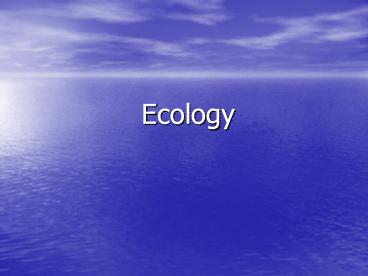Ecology - PowerPoint PPT Presentation
1 / 40
Title:
Ecology
Description:
... dry forest, tropical savannah, temperate grassland, desert, temperate woodland ... Each step in a food chain or a food web is called a trophic level. ... – PowerPoint PPT presentation
Number of Views:118
Avg rating:3.0/5.0
Title: Ecology
1
Ecology
2
What is Ecology?
- Study of interactions among
- 1. Organisms (Living-Living)
- 2. Organisms and their environment
(Living-Nonliving)
3
Species- a group of similar organisms that can
breed and produce fertile offspring.
4
3-2 Ecological Levels of Organization
Section 3-1
Go to Section
5
Levels of Organization
- Individual- one organism (living)
- Ex a moose
6
Levels of Organization
- Population- groups of individuals that belong to
the same species and live in the same area.
(living-living same species) - Ex many moose
7
Levels of Organization
- Community- groups of different populations (more
than one population or different groups of
species) - Ex many groups of moose beavers, trees, grass
(all living)
8
Levels of Organization
- Ecosystem- all organisms in a particular area
along with the nonliving. (living and nonliving) - Ex many groups of moose beavers, trees, grass,
rocks, water, mountains
9
Types of Ecosystems
- 3 major types of ecosystems
- 1. terrestrial ecosystems
- 2. aquatic ecosystems
- 3. saltwater (marine) ecosystems
10
Levels of Organization
- Biome- group of ecosystems that have the same
climate and similar dominant communities - Biomes tropical rain forest, tropical dry
forest, tropical savannah, temperate grassland,
desert, temperate woodland and shrub land,
temperate forest, northwestern coniferous forest,
boreal forest (taiga), tundra, mountains and ice
caps Water Biomes Freshwater, Marine,
11
BIOMES
- A group of ecosystems that have the same climate
and similar communities
12
Levels of Organization
- Biosphere- all of the planet where life exists,
includes land, water, and, air - Life extends 8 km up and 11 km below the surface
13
BIOSPHERE
- The highest level of organization
14
(No Transcript)
15
(No Transcript)
16
(No Transcript)
17
(No Transcript)
18
What shapes an ecosystem?
- Biotic factors- biological (living) influences on
ecosystem - Ex. Interactions between organisms, predation,
symbiosis, etc.
- Abiotic factors- nonliving influences on
ecosystems - Ex. Temperature, precipitation, nutrient
availability, sol type, sunlight.
19
Biotic- anything living
20
Abiotic- anything non-living
21
Habitat vs. Niche
- Habitat- an area where an organism lives
- Niche- full range of physical and biological
conditions in which an organism lives and the way
in which the organism uses those conditions.
Includes where in the food chain it is, where an
organism feeds - Habitat is like an address in an ecosystem and a
niche is like the job in an ecosystem.
22
The need for energy (ATP) to power life processes
is the most important aspect of an organisms
interaction with its environment
23
SUNLIGHTis the main energy source of most living
systems
24
Energy Flow (Trophic Levels)
- Producers- make their own food
- Consumers- get energy from consuming producers
25
Producers
- Producers- capture energy from sunlight or
chemicals and use the energy to produce food. - Producers are autotrophs- they make food from
their environment
26
Autotrophs
- Get energy from the sun-by photosynthesis
- Get energy without light- by chemosynthesis
27
Consumers
- Consumers are heterotrophs- get energy from other
organisms
28
Types of Consumers
- Herbivores- eat only plants
- Carnivores- eat animals
- Omnivores- eat both plants and animals
- Detritivores- eat dead matter (plants and animals)
29
(No Transcript)
30
(No Transcript)
31
(No Transcript)
32
(No Transcript)
33
Feeding Relationships
- Energy flows through an ecosystem in one
direction from - 1. the sun or inorganic compounds
- 2. To autotrophs (producers)
- 3. To heterotrophs (consumers)
- Decomposers get energy from decomposing dead
organisms
34
Food Chain- a series of steps in which organisms
transfer energy by eating or being eaten.
- Food Web- A network of feeding relationships.
- (More realistic that a food chain)
35
Food Chains
- Nutrients and energy move from autotrophs to
heterotrophs to decomposers - Food chains are drawn with arrow pointing in
direction of energy flow org that consumes will
have mouth to eat food source. - grasshopper?robin
- robin?grasshopper
- Food chains can be made up 3 links, but seldom
have more than 5 due to loss of energy as heat.
36
Trophic levels
- Each step in a food chain or a food web is called
a trophic level. - Producers are the first trophic level
- Consumers are the second, third, or higher
trophic level - Each trophic level depends on the one below for
energy
37
(No Transcript)
38
Energy Pyramid
- Only part of the energy stored in one level can
be passed to the next- most energy is consumed
for life processes (respiration, movement, etc.,
and heat is given off) - Only 10 of the energy available within one
trophic level is transferred to organisms in the
next trophic level - Less than 1 is actually used by organisms on
Earth
39
Biomass Pyramid
- Biomass- the total amount of living tissue within
a given trophic level. - A biomass pyramid represents the amount of
potential food available for each trophic level
in an ecosystem.
40
PYRAMID OF NUMBERS































